2nd Lieut. George Alfred Kendall (295672)
(Pioneer Platoon, Support Company)
George Alfred Kendall was born in 1914. At the start or World War 2, George
Alfred Kendall was already serving with the Auxiliary Fire Service.
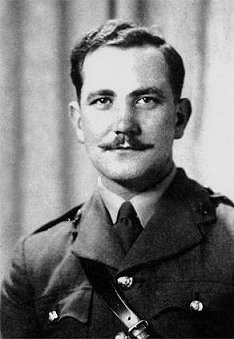
2/Lieut. George Alfred Kendall
Early in 1943 he was called up from the
Auxiliary Fire Service for army service as a regular soldier (5256300).
First reported at Burton on Trent, then training exercises somewhere in the
north east of the country, also Pembury beaches with mock ups in preparation
for Normandy landings. Then on to a camp at Market Rasen, Lincolnshire, with
the 8th Battalion Worcestershire Regiment (where he met his wife to be,
Rowena Hill who was cajoled into sewing on his 'sergeant stripes'.) At
Market Rasen training included Bren Carriers.
Lieutenant Kendall married Rowena Hill on the 16th October 1943, the same
day that he was commissioned from the ranks as a 2nd Lieutenant.
He was then drafted in to the 1st Battalion Worcestershire Regiment who were
at Maresfield Camp in Sussex. This was followed by another move in November
to Hythe, Kent and here as a platoon commander in 'D' Company with Major
Peter Weston, he took charge of 18 Platoon.
In June 1944 the 1st Battalion was now at Heathfield. It was here that the
existing officer in charge of the Pioneer Platoon, Captain ???? was
transferred to take command of another Company. Lieutenant Kendall was
'selected' for a crash pioneer course while at Heathfield (included blowing
up trees & railway lines also very brief mine defusing instruction etc.) and
became the Battalion Pioneer Officer in Support Company commanded by Captain
Peter Roose.
On the 17th June 1944 he left with Support Company and Motor Transport for
Tilbury Docks, where they embarked on the transport ship “Empire Duke”
(MT48) and sailed on the afternoon of the 18th June 1944. Due to the heavy
storms there were delays at sea and Lieutenant Kendall recalls spending the
first night sleeping on deck with others as it was so hot, but then being
ordered below away from danger from enemy aircraft.
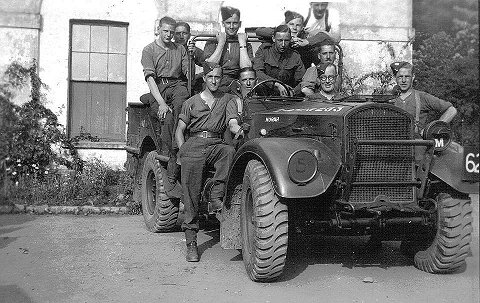
Worcestershire Regiment men at Market Rasen (1943)
Next move was on to the village of Cheux, but on the 28th June 1944, Lieutenant Kendall’s luck ran out and he was hit in the face from German mortar fire at the village of Cheux. He was treated at the R.A.P. and then sent to Field Ambulance and finally returned back to England for further treatment and convalescence.
Below is a copy of that letter dated 24th July 1944;
Dear Ron,
This notepaper no doubt appears familiar to you, and yes! Of course I have already met your pal – whom I call ‘Jock’. He doesn’t seem to mind. He’s already told you of this place and its amenities, so that saves me. Instead, I had better devote my letter to satisfying your thirst for details.
Firstly let me correct an incorrect impression. My moustache is still growing. Only a small portion was cut away, and the scar scarcely shows at all.
Well Ron, we didn’t go over on ‘D-Day’ as you know. However when we did, I went with all the Battalion transport – carriers etc. in an MT or Motor Transport. This was a cargo boat of the Empire class – built in Canada last September.
It was awfully crowded, and unfortunately we fell for the bad weather and rough seas, about which you have heard so much about.
As a matter of fact we were 7 days on board all told. When we reached the Normandy coast it was much too rough to unload for a few days. However, when we did get ashore it was to find that the rest of the Battalion had been on French soil for a number of days, and, as the division was moving up, we’d got to ‘chase it’ and reach them as soon as possible.
The vehicles were landed in smaller vessels on different parts of the beach, and some were very late turning up at the Beach Transit areas.
I stayed until last to bring up the remaining trucks, and boy! What a journey it was up those French roads!
Guess you’ve seen those French maps we have. Well you don’t have to believe everything you read on them! And the traffic! Gosh – you’d wonder how we managed to get all that stuff over.
All the ideas - and ideals of dispersion and convoy spacing, seemed to be either forgotten or ignored – in the areas near the coast – anyway.
As you know, I’ve never been on the continent before, but the French villages and roads, were much as I’d imagined them from books.
At first – near the coast – the villages and farm houses were pretty intact, but the nearer to the fighting, the more they had been knocked about
Most of the people I saw, were pretty middle aged or aged. It was strange to think that they had been living with the Germans, and after existing through the battle for their little village – were now – somewhat disinterestedly watching the British rumble and clatter through, along their cobbled streets.
Now and then an old woman would wave.
At Courselle Sur Mer, a somewhat aloof and aristocratic family were dining – you could see them clearly through their wrecked doors and windows. The girl appeared very beautiful and aloof! They took not the slightest notice of us.
Two messages were received en-route – altering our destination, and in the end I joined the Battalion just as the C.O. was finishing his ‘O’ Group for the move up into battle on the morrow.
This was a little awkward, but as I have a very reliable Sergeant – had to be content with taking the orders from him, and checking with Peter Rouse our Company Commander.
It was then 2100 hrs, and there was a hell of a lot to be done.
Suspicious looking objects – supposedly mines – had been found by different companies – so had to investigate. Did they realise I wonder that my guess was as good as theirs?
Umpteen orders to be read by myself and to the Platoon. Letters to be censored.
3 tonner and jeeps to be unpacked and repacked for the morrow.
I was to travel with an assault section – with Recce Group in the morning – ‘How the hell am I to get an Assault Section (5 persons) and myself – and stores for mine clearing etc in one jeep?’
Twelve thirty or 0030 hrs. when I lay down.
Battle tomorrow? No time to worry about that – it’s the little things that take your mind.
A terrific barrage is going on a little to the south, on the places we are moving into or moving towards tomorrow.
The next day after a few preliminaries – Recce Group moves off.
Progress is slow – along tracks which are mapped as second class roads. We move by bounds – visualising the Brigade Command a little ahead all the time.
Information about the battle ahead reaches us – and we follow the progress on the map.
We are to hold Cheux while the spearhead pushes on. Strong counter attacks are expected.
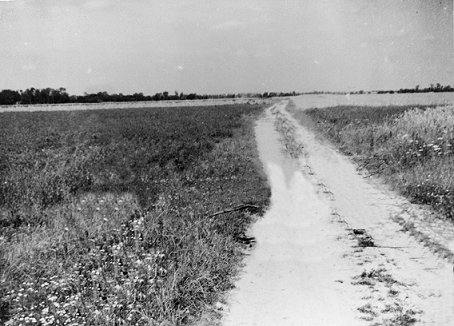
Road track leading to Cheux which the 1st Worcesters took (June 1944)
Ambulances pass us with their loads of wounded, going towards the rear.
Farmhouses are knocked to pieces. There are no civilians now!
Knocked out tanks are numerous and at one stop – two RAMC men move towards a tank to take out one of our men who has had his head blown clean off by a shell passing through the turret!
A mile or so further on, and on a track – cleared and taped through a mine field – we can progress no further.
We pull into one side amongst a profusion of tanks and other vehicles.
Later on, the tanks and infantry form up for the attack.
All the while – guns around us are keeping up an unceasing din. At first you can’t help jumping when one fires just behind you, but you get used to it.
We watch the attack move forward towards the ridge – behind which is the town of Cheux.
Snipers on the left – are soon routed out, but on the right – in a wood, must be a much stronger force.
It doesn’t seem possible at first, that over there, are Jerries – firing at us.
However – it seems common sense to either lie down, or get around the other side of the stationary tank on our left.
Then a few tanks move over towards the woods, to let rip with their Besas. An earsplitting cracking starts up.
More tanks join in. One doesn’t move any more, but its gun still speaks!
A lull – only to be broken by the noise of German MG 34 and 42.
It all starts up again, and after another hour and a half – a long line of Jerries are moved out of the woods by a few infantrymen. The Germans hold their hands clasped over their heads – apart from those supporting an injured comrade. There are roughly fifty of them. I wonder how many left behind.
Most of these men are determined - fanatical youths of the Hitler Youth, and our fellows had been told this morning before we left them, of the tricks they used, to catch and kill the British Tommy. Some would paint their faces a sickly green colour, and lie as if dead, then shoot the unsuspecting Tommy as he passed by.
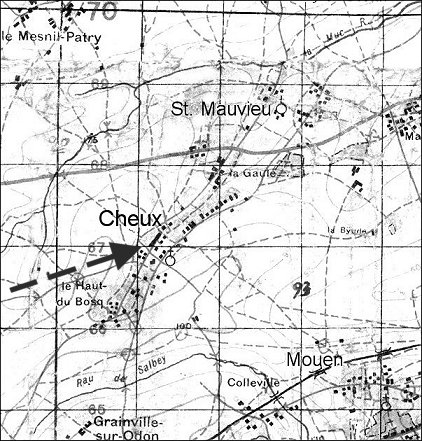
Worcesters advance on Cheux (27th June 1944)
Well later on we moved up to the crossroads just north of the ridge – to the south of which we were to hold the town.
It was getting late then. The Company Commanders and most of the ‘R’ Group were to move back to the Battalion and lead their company’s back in the very early hours of the morning.
I was to form a control point where we stood and control them in.
So I had the doubtful pleasure of stopping the night in the pouring rain, in a very deep and wide ditch. The I.O. (Lieut. Roy Humphreys) and C.O. (Lieut.-Colonel A. R. Harrison) were my companions.
By now the track and its proximity was a quagmire, and by 0400 hrs. when we emerged, its conditions were unprintable.
As Tennyson (was it) says, ‘So all day long the noise of battle rolled’ only it was all night.
The Battalion which had taken the ground had now dug in.
Then the first Battalion in the Brigade arrived and passed through, looking very weary, followed by our ‘A’ Company.
I never knew as I greeted ‘A’ Company officers and joked with them, that it would be for the last time. Eight hours later – a mortar bomb landed smack in the centre of their ‘O’ Group and wiped the lot out. Terrible luck!
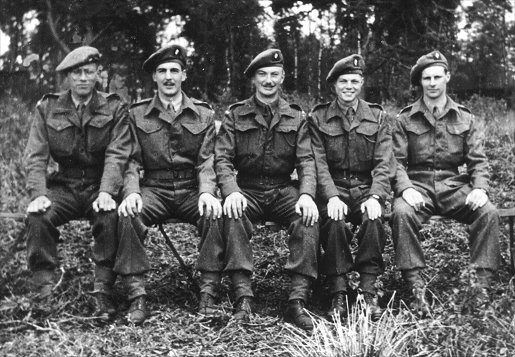
1st Battalion Worcestershire, 'A' Company Officer all killed at Cheux
(27th June 1944)
L. to R: Lieut. David Wye, Capt. Richard Dingley, Major Peter Riddle,
(Batman), Lieut. Patrick Hulme
(Lieut. Patrick Hulme died of his wound later the same day)
To the uninitiated it would have looked pretty chaotic, but I guess everyone knew what they were about.
Then some carriers and riflemen of a Scottish Division started to move through. A burly man in a pullover and field boots, splashed up, and told me to stop my troops from moving through as the ‘____’ were going into battle. ‘What is your name then?’
‘Brigadier ______’ came the reply.
‘Very good sir!’ Then up came our Brigadier, and he, for a change agreed that that was the correct thing to do, so that was O.K.
After most of the Battalion had passed through – naturally I wanted to rejoin my platoon, so with only one anti-tank gun to come – I received permission to rejoin.
About the first thing that happened was that I received from my batman, a huge pile of letters, including one from you.
There were still plenty of snipers and mortar fire, so the first thing was to join forces with my sergeant and get cracking on a slit trench. This didn’t take us long.
Then a tour around to find out the whereabouts of everyone.
Tanks were crashing through the village then, helping to increase the damage already done by the guns.
At about 1300 – 1330 hrs.- my duties took me into the courtyard of a farm, by our Battalion HQ, at the beginning of Cheux.
I moved out to assess any damage to my drivers or trucks which were nearby.
I remember one fellow had his back absolutely covered with blood, but he was walking alright, and I remember thinking that it must have splashed from someone else!
Just got outside into the roadway when – Crash! – something hit me such a smack in the mouth without any warning. Down again at the bottom of a wall, and in the roadway I threw myself.
I was scared! – this time! – spitting blood and bits of teeth (which I quite thought were bone!) into the roadway. I remember – I thought – probably my jaw has been shot away.
Another crash! – and another! Yes I remember – for a few moments I knew what fear really was!
Then it stopped.
A motorcycle standing near me was knocked to pieces.
I walked along to Battalion H.Q. where I met my Platoon Sergeant – and the C.O. I was trying to tell Sergeant Preece what to do, and the C.O. was telling me to go to R.A.P. (sic Regimental Aid Point).
I heard my old company commander shouting for stretcher bearers! And my mouth kept filling with blood.
Found the M.O. very busy – and got straight into one of his deep slits. Its funny the respect you get for Jerries mortars after you’ve ‘met a piece’. The Doc only had some shell dressings. His two trucks hadn’t turned up. He slapped one straight over my mouth, and one of the orderlies took me along to the Field Ambulance.
On the way we passed a chap who was beyond any help at all. A horrible sight, but you don’t take so much notice at the time.
From here – to an ambulance – and the commencement – stage by stage – of the journey back, and questions and labels, which will all finish when I leave here.
Then seven days leave, after which – a Reinforcement Holding Unit – From there to – well who knows.
I shall be Grade A.
I’m all right now. Only putting on more weight, that’s all.
That I think, tells you all you want to know Ron. That’s if you can read this scrawl. One excuse I have, is that owing to the fact that I broke my pen, and discarded it in Normandy, I have to use the pens – and nibs provided.
Bye Bye Ron, I hope this hasn’t been too much for you.
George
Acknowlegdement: This letter was kindly provided by Captain George Alfred Kendall’s son John and printed with the permission of his father. Sadly, Captain George Alfred Kendall died at home in Devon on Saturday 26th May 2007 at the age of 93. His funeral was held on Wednesday 6th June 2007 in Devon.
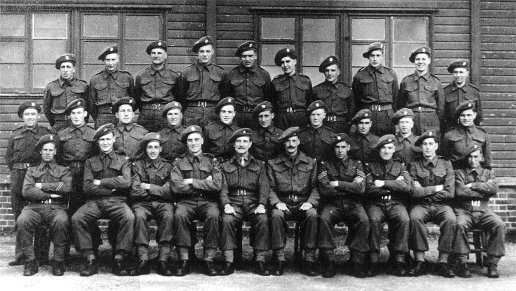
1st Battalion Worcestershire Regiment - 'D' Company - 18 platoon at
Turnpike Camp, Hythe (April 1944)
Back: Pte. Hansford, Pte. Knight, Pte. Wakeman, Pte. Davis, Pte. Lowe, Pte.
Green, Pte. Harrison, Pte. Stevenson, Pte. Worton, Pte. Dodds
Middle: Pte. Holdcroft, Pte. Heveron, Pte. Cadwallader, Pte. Legge, Pte.
Jenkins, Pte. Keast, Pte. Gilbert, Pte. Wickendon, Pte. Long, Pte. White
Front row: Pte. Mellor, Pte. Foulds, L/Cpl. Proctor, L/Cpl, Johnson,
2nd Lieut. G. A. Kendall, Major P. T. Weston,
Sgt. Slim, L/Cpl. Palmer, Pte. Lennon, Pte. Stewart